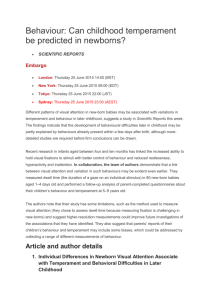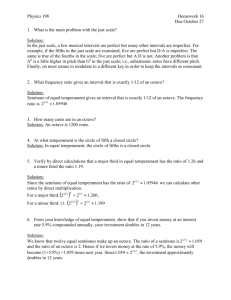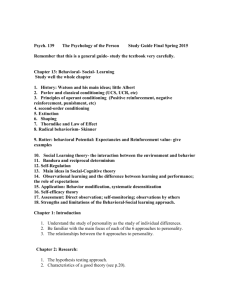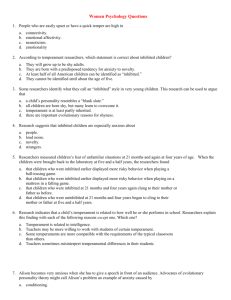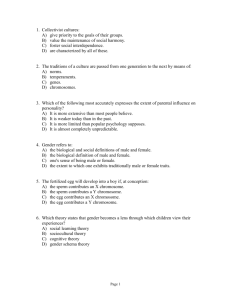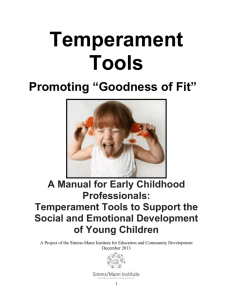Temperament & Personality: Biological Approach Study Notes
advertisement
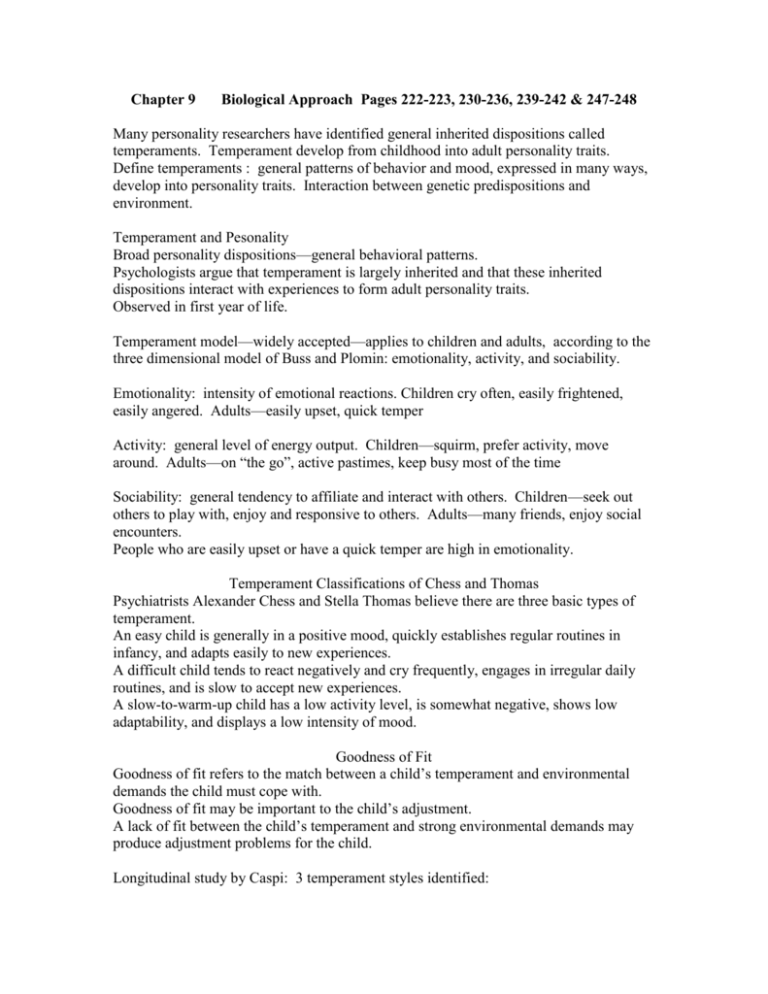
Chapter 9 Biological Approach Pages 222-223, 230-236, 239-242 & 247-248 Many personality researchers have identified general inherited dispositions called temperaments. Temperament develop from childhood into adult personality traits. Define temperaments : general patterns of behavior and mood, expressed in many ways, develop into personality traits. Interaction between genetic predispositions and environment. Temperament and Pesonality Broad personality dispositions—general behavioral patterns. Psychologists argue that temperament is largely inherited and that these inherited dispositions interact with experiences to form adult personality traits. Observed in first year of life. Temperament model—widely accepted—applies to children and adults, according to the three dimensional model of Buss and Plomin: emotionality, activity, and sociability. Emotionality: intensity of emotional reactions. Children cry often, easily frightened, easily angered. Adults—easily upset, quick temper Activity: general level of energy output. Children—squirm, prefer activity, move around. Adults—on “the go”, active pastimes, keep busy most of the time Sociability: general tendency to affiliate and interact with others. Children—seek out others to play with, enjoy and responsive to others. Adults—many friends, enjoy social encounters. People who are easily upset or have a quick temper are high in emotionality. Temperament Classifications of Chess and Thomas Psychiatrists Alexander Chess and Stella Thomas believe there are three basic types of temperament. An easy child is generally in a positive mood, quickly establishes regular routines in infancy, and adapts easily to new experiences. A difficult child tends to react negatively and cry frequently, engages in irregular daily routines, and is slow to accept new experiences. A slow-to-warm-up child has a low activity level, is somewhat negative, shows low adaptability, and displays a low intensity of mood. Goodness of Fit Goodness of fit refers to the match between a child’s temperament and environmental demands the child must cope with. Goodness of fit may be important to the child’s adjustment. A lack of fit between the child’s temperament and strong environmental demands may produce adjustment problems for the child. Longitudinal study by Caspi: 3 temperament styles identified: Well adjusted---self-controlled and self confident, ok with new situations and people. Undercontrolled—impulsive, restless, easily distracted. Inhibited—fearful, reluctant in social situations, uneasy around strangers. Children identified as inhibited show a fear of unfamiliar situations that other children do not. There is evidence that this tendency is inherited and that it remains fairly stable throughout childhood. How others react and whether interact to child partly determined by temperament Disposition of the child influences type of environment lives in Inherit the tendency to react to unfamiliar situations with inhibited style (Kagan) Inhibited children—controlled and gentle. Cling to parent new setting and slow to explore Uninhibited children—energetic and spontaneous, easily explore and leave parent in new setting. Researchers: inhibited children are born with a predisposed tendency for anxiety to novelty. Turn away from strangers & seek comfort way to express anxiety about new situations. Other differences found Some researchers identify what they call an "inhibited" style in very young children. This research can be used to argue that temperament is at least partly inherited A five-year-old boy is controlled and gentle. He is reluctant to play with new children and hesitates when entering new situations. Temperament researchers probably would identify this child as inhibited. Research on the academic performance of elementary school children has found temperament plays a role in how well children do in school. explained with the following reasons: Teachers may be more willing to work with students of certain temperament; some temperaments are more compatible with the requirements of the typical classroom than others; and teachers sometimes misinterpret temperamental differences in their students. Psychologists argue that different learning procedures to meet the needs of each student's temperament should be used-- based on the "Goodness of Fit" Model-- educators should ask what kind of environment and procedures are most conducive to learning for this student, given his or her temperament. Children will learn best when the demands of the learning environment match the child’s temperament. Implications for teaching: studies find that children identified with a difficult temperament pattern and those identified with a slow-to-warm-up pattern perform more poorly in school than children identified with an easy temperament pattern. Trina is slow to warm up to a new task. Rather than jumping right into a new assignment, she spends a great deal of time getting prepared and trying to understand the entire project. Because of her temperament, Trina usually falls behind the other students in her third-grade class. According to the Goodness of Fit model, Trina's teacher should adapt her teaching to meet Trina's style of learning. Strength of biological approach: it ties personality psychology to the discipline of biology. research has identified realistic limitations on the "blank slate" model of personality development. Another strength of biological approach is strong emphasis on research. Criticisms include the difficulty researchers have in testing some of their ideas directly. Other criticisms are that there is no agreed-upon model for temperament researchers and that the biological approach provides little information about behavior change. Similar to page 265 in text: 9 Temperamental Dimensions: Thomas & Chess Temperament and Personality The following nine dimensions of temperament are those outlined by Thomas and Chess in their studies of infant personality characteristics. Thomas and Chess were convinced that temperament continued to play a role throughout a child’s later development. 1. Activity Level: This category assesses motor activity. It includes mobility during bathing, eating, and playing. It includes the amount of reaching, crawling, and walking exhibited by the child. It also assesses the sleep-wake cycle. High-activity children wiggled, squirmed, kicked, and were generally “on the go.” Low-activity children were quiet, still, and placid. 2. Rhythmicity: This category assessed the regularity of children’s sleep, wakefulness, eating, and elimination. Children high in rhythmicity showed regular, predictable patterns of biological functioning. Children low in rhythmicity showed unpredictable and irregular biological patterns. 3. Approach or Withdrawal: This category assessed a child’s initial response to new stimuli. As new stimuli were introduced, some children approached the stimuli readily and quickly engaged in the stimuli. Other children displayed very negative reactions to new stimuli: crying, fussing, avoiding, or withdrawing. 4. Adaptability: This category focused on later reactions to new stimuli. After the initial response, researchers observed later reactions and behaviors. Nonadaptive children did not change their initial reaction to the stimulus. Adaptive children either responded positively initially or, after initially displaying a negative response, began to gradually adapt to and engage with the stimulus. 5. Threshold of Responsiveness: This category assessed the stimulus threshold needed to elicit a response. Higher thresholds indicated that larger amounts of stimuli were required to get a response. Lower thresholds indicated that a minimal amount of stimulus elicited a response. 6. Intensity of Reaction: This category assessed the energy level with which the child responded to the environment. A high-intensity reactor might scream or express extreme rage when frustrated. A low-intensity reactor tended to take things “more in stride.” 7. Quality of Mood: This category assessed overall mood state as positive or negative in quality. Positive-mood-state children smiled more often, were friendly, and laughed frequently. Negative-mood-state children were unpleasant to others, unfriendly, and displayed a sad affect. 8. Distractibility: This category assessed how easily a child could be distracted by influences in the environment. A distractible child’s behavior was easily interrupted by external stimuli, whereas a nondistractible child’s behavior was not influenced by extraneous environmental cues. 9. Attention Span and Persistence: This category assessed both attention span (how long a child would pursue a particular activity) and persistence (the continuation of the activity when obstacles were placed in the way). Some children were high in attention span but not in persistence. Some children were assessed to be low in both attention span and persistence.

